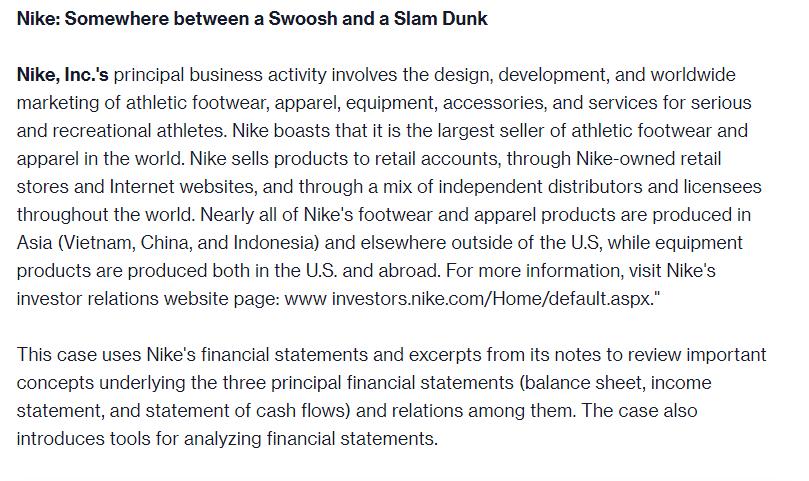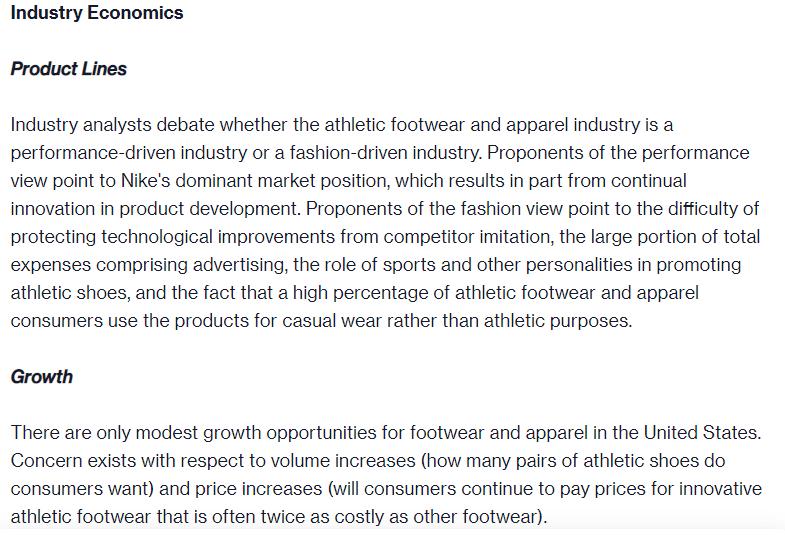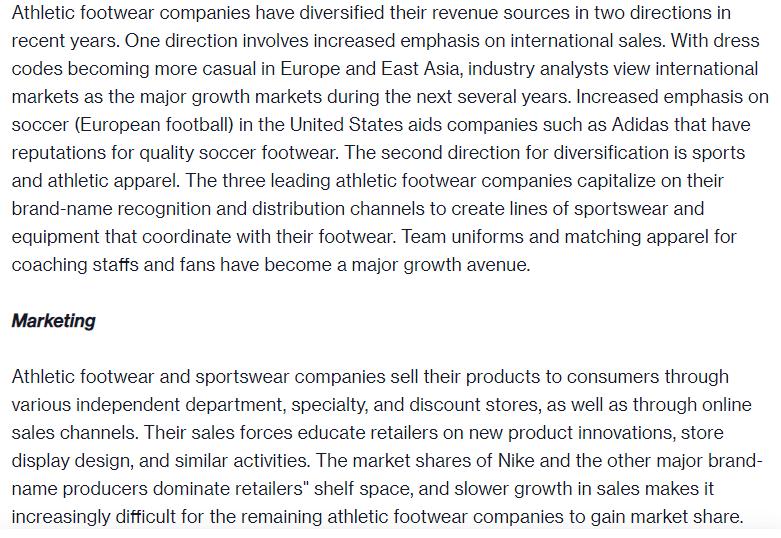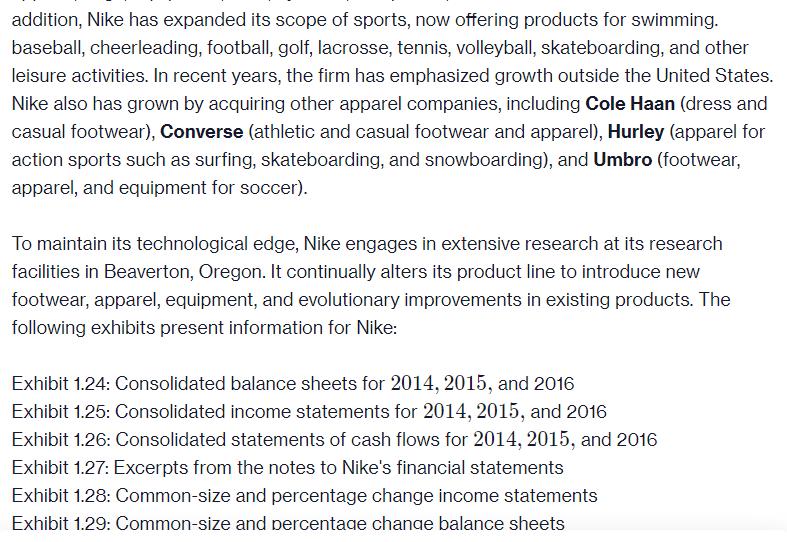Answered step by step
Verified Expert Solution
Question
1 Approved Answer
Nike: Somewhere between a Swoosh and a Slam Dunk Nike, Inc.'s principal business activity involves the design, development, and worldwide marketing of athletic footwear,






Nike: Somewhere between a Swoosh and a Slam Dunk Nike, Inc.'s principal business activity involves the design, development, and worldwide marketing of athletic footwear, apparel, equipment, accessories, and services for serious and recreational athletes. Nike boasts that it is the largest seller of athletic footwear and apparel in the world. Nike sells products to retail accounts, through Nike-owned retail stores and Internet websites, and through a mix of independent distributors and licensees throughout the world. Nearly all of Nike's footwear and apparel products are produced in Asia (Vietnam, China, and Indonesia) and elsewhere outside of the U.S, while equipment products are produced both in the U.S. and abroad. For more information, visit Nike's investor relations website page: www investors.nike.com/Home/default.aspx." This case uses Nike's financial statements and excerpts from its notes to review important concepts underlying the three principal financial statements (balance sheet, income statement, and statement of cash flows) and relations among them. The case also introduces tools for analyzing financial statements. Industry Economics Product Lines Industry analysts debate whether the athletic footwear and apparel industry is a performance-driven industry or a fashion-driven industry. Proponents of the performance view point to Nike's dominant market position, which results in part from continual innovation in product development. Proponents of the fashion view point to the difficulty of protecting technological improvements from competitor imitation, the large portion of total expenses comprising advertising, the role of sports and other personalities in promoting athletic shoes, and the fact that a high percentage of athletic footwear and apparel consumers use the products for casual wear rather than athletic purposes. Growth There are only modest growth opportunities for footwear and apparel in the United States. Concern exists with respect to volume increases (how many pairs of athletic shoes do consumers want) and price increases (will consumers continue to pay prices for innovative athletic footwear that is often twice as costly as other footwear). Athletic footwear companies have diversified their revenue sources in two directions in recent years. One direction involves increased emphasis on international sales. With dress codes becoming more casual in Europe and East Asia, industry analysts view international markets as the major growth markets during the next several years. Increased emphasis on soccer (European football) in the United States aids companies such as Adidas that have reputations for quality soccer footwear. The second direction for diversification is sports and athletic apparel. The three leading athletic footwear companies capitalize on their brand-name recognition and distribution channels to create lines of sportswear and equipment that coordinate with their footwear. Team uniforms and matching apparel for coaching staffs and fans have become a major growth avenue. Marketing Athletic footwear and sportswear companies sell their products to consumers through various independent department, specialty, and discount stores, as well as through online sales channels. Their sales forces educate retailers on new product innovations, store display design, and similar activities. The market shares of Nike and the other major brand- name producers dominate retailers" shelf space, and slower growth in sales makes it increasingly difficult for the remaining athletic footwear companies to gain market share. The slower growth also has led the major companies to increase significantly their advertising and payments for celebrity endorsements. Many footwear companies, including Nike, have opened their own retail stores, as well as factory outlet stores for discounted sales of excess inventory. Athletic footwear and sportswear companies have typically used independent distributors to market their products in other countries. With increasing brand recognition and anticipated growth in international sales, these companies have recently acquired an increasing number of their distributors to capture more of the profits generated in other countries and maintain better control of international marketing. Nike Strategy Nike targets the serious athlete as well as the recreational athlete with performance-driven footwear, apparel, and equipment. The firm has steadily expanded the scope of its product portfolio from its primary products of high-quality athletic footwear for running, training, basketball, soccer, and casual wear to encompass related product lines such as sports apparel, bags, equipment, balls, eyewear, timepieces, and other athletic accessories. In addition, Nike has expanded its scope of sports, now offering products for swimming. baseball, cheerleading, football, golf, lacrosse, tennis, volleyball, skateboarding, and other leisure activities. In recent years, the firm has emphasized growth outside the United States. Nike also has grown by acquiring other apparel companies, including Cole Haan (dress and casual footwear), Converse (athletic and casual footwear and apparel), Hurley (apparel for action sports such as surfing, skateboarding, and snowboarding), and Umbro (footwear, apparel, and equipment for soccer). To maintain its technological edge, Nike engages in extensive research at its research facilities in Beaverton, Oregon. It continually alters its product line to introduce new footwear, apparel, equipment, and evolutionary improvements in existing products. The following exhibits present information for Nike: Exhibit 1.24: Consolidated balance sheets for 2014, 2015, and 2016 Exhibit 1.25: Consolidated income statements for 2014, 2015, and 2016 Exhibit 1.26: Consolidated statements of cash flows for 2014, 2015, and 2016 Exhibit 1.27: Excerpts from the notes to Nike's financial statements Exhibit 1.28: Common-size and percentage change income statements Exhibit 1.29: Common-size and percentage change balance sheets REQUIRED Study the financial statements and notes for Nike and respond to the following questions. Income Statement a. Identify when Nike recognizes revenues. Does this timing of revenue recognition seem appropriate? Explain.
Step by Step Solution
★★★★★
3.57 Rating (161 Votes )
There are 3 Steps involved in it
Step: 1
a Ident ify when Nike recognizes revenues ANS WER N i...
Get Instant Access to Expert-Tailored Solutions
See step-by-step solutions with expert insights and AI powered tools for academic success
Step: 2

Step: 3

Ace Your Homework with AI
Get the answers you need in no time with our AI-driven, step-by-step assistance
Get Started


